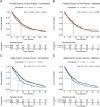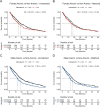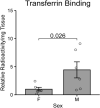Analysis of anemia and iron supplementation among glioblastoma patients reveals sex-biased association between anemia and survival
- PMID: 38287054
- PMCID: PMC10825121
- DOI: 10.1038/s41598-024-52492-8
Analysis of anemia and iron supplementation among glioblastoma patients reveals sex-biased association between anemia and survival
Abstract
The association between anemia and outcomes in glioblastoma patients is unclear. We analyzed data from 1346 histologically confirmed adult glioblastoma patients in the TriNetX Research Network. Median hemoglobin and hematocrit levels were quantified for 6 months following diagnosis and used to classify patients as anemic or non-anemic. Associations of anemia and iron supplementation of anemic patients with median overall survival (median-OS) were then studied. Among 1346 glioblastoma patients, 35.9% of male and 40.5% of female patients were classified as anemic using hemoglobin-based WHO guidelines. Among males, anemia was associated with reduced median-OS compared to matched non-anemic males using hemoglobin (HR 1.24; 95% CI 1.00-1.53) or hematocrit-based cutoffs (HR 1.28; 95% CI 1.03-1.59). Among females, anemia was not associated with median-OS using hemoglobin (HR 1.00; 95% CI 0.78-1.27) or hematocrit-based cutoffs (HR: 1.10; 95% CI 0.85-1.41). Iron supplementation of anemic females trended toward increased median-OS (HR 0.61; 95% CI 0.32-1.19) although failing to reach statistical significance whereas no significant association was found in anemic males (HR 0.85; 95% CI 0.41-1.75). Functional transferrin-binding assays confirmed sexually dimorphic binding in resected patient samples indicating underlying differences in iron biology. Anemia among glioblastoma patients exhibits a sex-specific association with survival.
© 2024. The Author(s).
Conflict of interest statement
The authors declare no competing interests.
Figures





Similar articles
-
The role of iron in the management of chemotherapy-induced anemia in cancer patients receiving erythropoiesis-stimulating agents.Cochrane Database Syst Rev. 2016 Feb 4;2(2):CD009624. doi: 10.1002/14651858.CD009624.pub2. Cochrane Database Syst Rev. 2016. PMID: 26845108 Free PMC article.
-
Treatment options for progression or recurrence of glioblastoma: a network meta-analysis.Cochrane Database Syst Rev. 2021 May 4;5(1):CD013579. doi: 10.1002/14651858.CD013579.pub2. Cochrane Database Syst Rev. 2021. PMID: 34559423 Free PMC article.
-
Association Between Preoperative Anemia and Cognitive Function in a Large Cohort Study of Older Patients Undergoing Elective Surgery.Anesth Analg. 2025 Jan 1;140(1):14-23. doi: 10.1213/ANE.0000000000006998. Epub 2024 Jul 10. Anesth Analg. 2025. PMID: 38985884
-
Intermittent oral iron supplementation during pregnancy.Cochrane Database Syst Rev. 2015 Oct 19;2015(10):CD009997. doi: 10.1002/14651858.CD009997.pub2. Cochrane Database Syst Rev. 2015. PMID: 26482110 Free PMC article.
-
Multiple-micronutrient supplementation for women during pregnancy.Cochrane Database Syst Rev. 2017 Apr 13;4(4):CD004905. doi: 10.1002/14651858.CD004905.pub5. Cochrane Database Syst Rev. 2017. Update in: Cochrane Database Syst Rev. 2019 Mar 14;3:CD004905. doi: 10.1002/14651858.CD004905.pub6. PMID: 28407219 Free PMC article. Updated.
Cited by
-
Iron content of glioblastoma tumours and role of ferrous iron in the hypoxic response in vitro.Front Oncol. 2025 Mar 7;15:1536549. doi: 10.3389/fonc.2025.1536549. eCollection 2025. Front Oncol. 2025. PMID: 40123902 Free PMC article.
References
MeSH terms
Substances
Grants and funding
LinkOut - more resources
Full Text Sources
Medical

